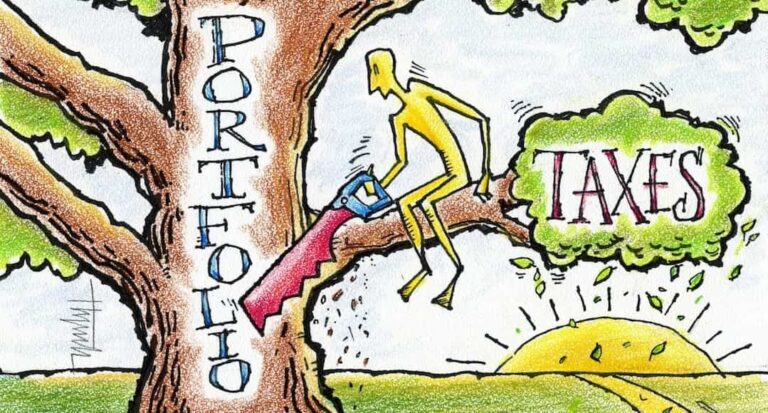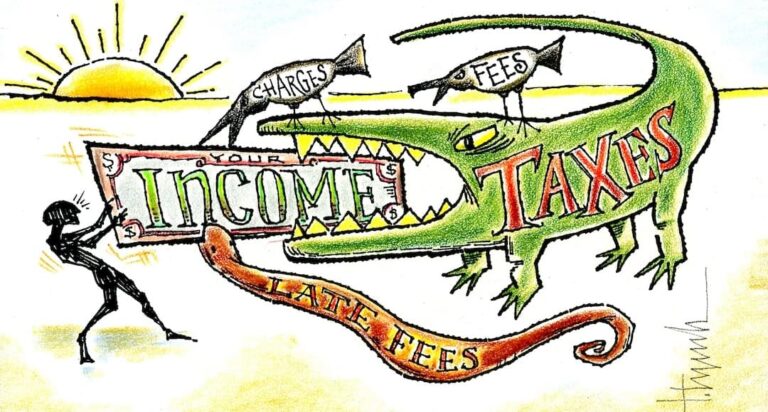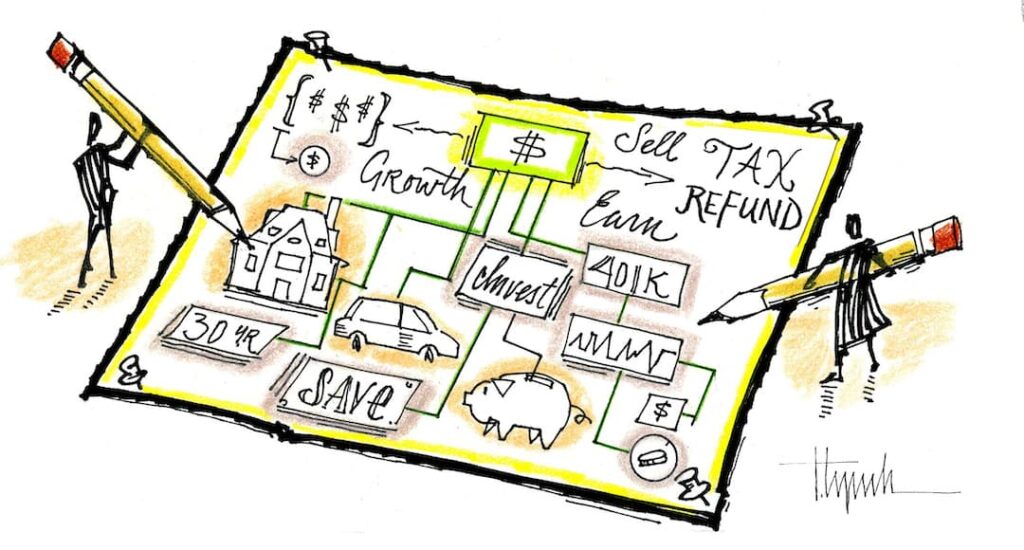
During the fourth quarter of each year, we often meet with clients to review their financial plans and prepare for tax season. I am always impressed by their willingness to carve time out of their busy schedules. But I’m glad they do because most need a customized year-end financial checklist for their situation.
We sometimes use a generic financial planning checklist to guide this process, which you are welcome to download. However, we recommend pairing it with the contextual insights below. For those who want to prepare, don’t have time to meet, or have yet to find a holistic financial planner, consider the following tips for making smart money moves.
Your End-of-Year Financial Checklist
1. Make Strategic Charitable Donations and Gifts
Although many give away small amounts of money all year, it is wiser to approach your giving strategically to lower your tax bill and maximize your impact. The tricky thing is that everyone’s situation is different, and the rules are constantly in flux, so it is best to consult a professional who can give you tailored advice. There are many strategies to consider (bundling, donor-advised funds, etc.), but to show you what I mean, below are two opportunities many clients find appealing:
Qualified Charitable Distributions (QCDs) From Tax-Deferred Retirement Account(s)
When the Tax Cuts and Jobs Act (TCJA) took effect in 2018, it resulted in a much higher standard deduction and reduced opportunities for itemized deductions. The net effect of that change is that, for many people, itemizing no longer makes sense. Unfortunately, that also eliminates the tax benefit of charitable contributions.
However, suppose you have a personal or inherited retirement savings account subject to the required minimum distribution (RMD). That might make the Qualified Charitable Distribution (QCD) strategy compelling. Here’s how it works.
The IRS treats distributions from tax-deferred retirement accounts as income, i.e., they are subject to income tax. However, if you plan to donate to charity, you can do so directly from that account. That means the funds go straight to the charity and do not count as income. In other words, you get the tax break, the charity receives the total amount, and you can still claim the standard deduction. Win, win!
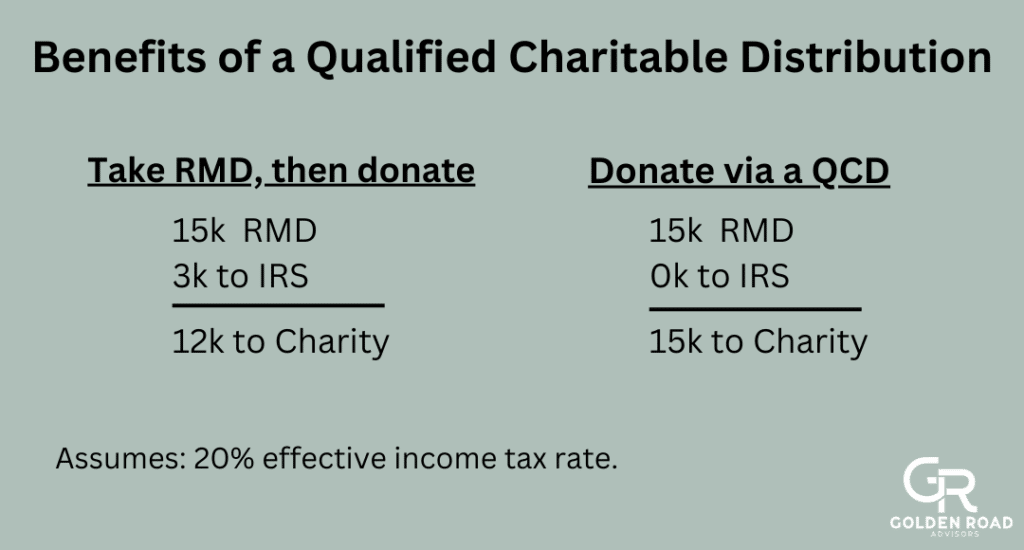
This strategy works best for people who are subject to required minimum distributions (RMDs), AND plan to take the standard deduction (vs. itemizing), AND wish to give to charity. Also, you must be at least 70 1/2 to employ this strategy.
If that is not true for you, there is another option.
Gifting Securities
If you possess appreciated securities (typically stocks) that you have held for over a year, you can gift them to charity and take a deduction at the full market value in most cases. That allows you to donate, take the deduction, and avoid the capital gains tax you would have paid if you simply sold that asset.
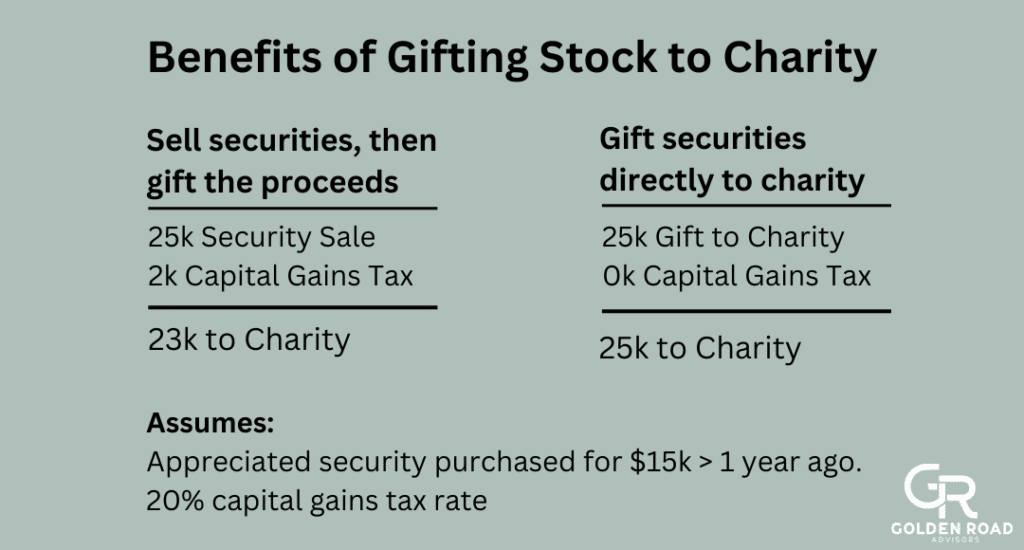
Read our blog post on charitable giving strategies for more ideas.
2. Wrap Up Required Minimum Distributions (RMDs) From Retirement Accounts
While we are on the subject, please take the required minimum distribution (RMD) from your tax-deferred retirement accounts. This is critical, yet young people (with inherited retirement accounts) often need a reminder.
Required minimum distributions apply to all employer-sponsored retirement plans and IRAs for people over 72 (or 73 if you reached age 72 after December 21, 2022). However, RMDs also apply to inherited accounts regardless of the recipient’s age. These rules are nuanced and subject to change, so please confirm what applies to you.
Failure to take the required distribution from the aggregation of every account to which it applies results in an egregious 50% tax (on the required amount). Also, you must pay income tax on the distribution, so plan accordingly.

3. Review Taxable Investment Accounts for Tax Loss Harvesting Opportunities
Another item for your year-end financial checklist is to review your taxable investment accounts to see what you will owe in taxes (for any gains) and consider harvesting losses. You can then use those losses to offset any gains for the year, offset up to $3,000 in ordinary income, or carry them forward to offset future gains.
Please know this is not an opportunity to “game” the system. Suppose you sell an investment at a loss and reinvest the funds into a “substantially identical security” within 30 days. In that case, the IRS will flag the transaction as a “wash sale,” negating any benefit.
In addition to offsetting capital gains, if you have suffered losses, this is also a good time to make changes to your portfolio. For example, I typically discourage clients from holding mutual funds in their taxable accounts for two reasons:
- The taxes on fund distributions can be costly in the long run.
- The trading behaviors inherent to mutual funds can expose them to the detrimental effects of market timing strategies.
Therefore, if we take on a new client with a taxable portfolio full of mutual funds, we actively look for opportunities to sell them. If the funds are down from their original investment, we will take the loss and reallocate the money into ETFs or index funds, likely reducing their tax bill for years to come.
4. Make Any Remaining Pre or After-Tax Contributions to Your HSA and Retirement Accounts
You can make 2024 contributions to Individual Retirement Accounts (Roth and Traditional IRAs) and health savings accounts (HSAs) until April 15, 2025. However, 401k contributions must occur by December 31st. Since many people rely on payroll deductions for these contributions, it is essential to check your pay stub to ensure you contribute as much as possible. As a reminder, the contribution limits for 2024 are as follows:
- HSA = $4,150 for individuals / $8,300 for families / +$1,000 for people 55 or older
- 401(k) = $23,000 for individuals / +$7,500 catch up for people aged 50 or older
- Traditional and Roth IRAs = $7,000 for individuals / +$1,000 catch up for people 50 or older (although Roth contributions are subject to income limits)
- SIMPLE IRAs = $16,000 for individuals / +$3,500 catch up for people aged 50 or older
- SEP IRAs = $69,000 for individuals
You can contribute to HSAs outside your payroll deduction if you haven’t funded these accounts as much as you would like.
You might be surprised to see health savings accounts in this discussion. Since you contribute pre-tax money to an HSA and distributions are not taxed (as long as you use them for medical care), your HSA can function as a tax-free savings vehicle. In addition, most accounts even offer investment opportunities. So, maximize your contributions whenever possible and let the money grow.
Pro Tip: Roth IRA conversions must also happen before December 31st to apply to the current tax year. Check out our article on MarketWatch for insight into the Roth IRA conversion strategy.
5. Explore Other Strategies to Maintain a Lower Tax Bracket
Making strategic charitable donations and ensuring that you meet the required minimum distributions (RMDs) for your retirement accounts (as discussed above) are the best ways to affect your tax bracket if all you have to work with are your personal finances.
However, if you are a small business owner or freelancer, ask an accountant or tax advisor for additional ideas. For instance, there may be lawful yet beneficial revenue recognition strategies to employ as you approach year-end.
6. Optimize Health Insurance Payouts
Take advantage of the cost-saving opportunities if you hit your health insurance plan’s individual or family deductible. For example, squeeze in any tests, exams, or procedures before December 31st for the best payouts. Conversely, if you have not reached your deductible, consider putting non-essential items off until 2025 to apply those costs to next year’s deductible.
If you have a flexible spending account (FSA), don’t forget that the funds may expire at year’s end or shortly after (depending on your plan’s rules). If this is the case for you and you still have funds in this account, consider using them to purchase medical supplies in bulk (like contact lenses, bandaids, etc.).
7. Consider the Impact of Familial Changes
As you customize your end-of-year financial checklist, consider any changes in your family and how they will affect your personal finances. For example, here are a few things that can have a significant impact:
- Divorce
If you recently divorced, your taxes would be different. In addition to a potential change in your filing status, only one person can claim dependents. Many former spouses simply alternate years, but you must intentionally develop an understanding to avoid mishaps. - Gaining or Losing a Family Member
If your family experienced a death, birth, or marriage, review your income tax withholding status for accuracy and confirm that you still have the correct beneficiaries assigned to your life insurance and financial accounts. - Inheritance
Money or assets received as an inheritance can also have an impact, depending on the source of the funds. For instance, distributions from an inherited annuity will increase your taxable income. If that will push you into a higher tax bracket, consider exploring strategies for managing that situation.
8. Review Your Financial Plans, Goals, and Progress
Year-end is a great time to revisit your short and long-term financial goals and plans, compare them to your progress, and make adjustments. As you engage in this exercise, here are a few specific items to consider.
- Retirement Accounts
Given what has transpired over the last year, are you still on track to meet your retirement goals? If not, explore additional opportunities to save money. - Emergency Funds
How much do you like to keep on hand for emergencies? Has that number changed, or did you deplete or grow those funds? If so, what do you need to do? - Rebalancing
Do you still have the right mix of investment assets to suit your risk profile? Things shift during the year, so take this opportunity to reestablish balance. - Anticipated Events or Milestones
Are you expecting a baby, sending a child to college, hitting a big birthday, or doing anything else that will result in significant expenditures or financial change? If so, how can you prepare? - Sneaky Expenses
Have you picked up any unnecessary costs over the past year that might affect your cash flow? For example, sometimes people accumulate debt on credit cards or home equity lines of credit with high interest rates or find that they are paying recurring fees for services they no longer use. Now is an excellent time to sleuth those things out and address them. - Gifting Opportunities
Do you want to give money to your children? If you wish to roll unused college funds into a Roth IRA or give them a tax-free gift (up to $18,000 in 2024), it may be beneficial to do so before year-end. College fund contributions, however, can occur anytime.
Your Year-End Financial Checklist: The Bottom Line
Year-end is a great time to optimize your financial situation. However, when deciding which financial moves to include on your end-of-year checklist, it is best to do so with a team of financial professionals who can help explain what applies to you. Specifically, any tax-related planning must receive the final approval of your accountant or tax advisor under their authority from the Internal Revenue Service to administer tax advice.
If we haven’t spoken already, please be sure to reach out. Also, don’t forget to download the checklist to complement the above information.
Then, relax and enjoy the holidays while spending some of your hard-earned money on something fun. After all, in the end, our goal is to empower you to set aside your worries and enjoy your life as we prepare for and enter the new year.
Author
-

Kevin Caldwell is a principal at Golden Road Advisors and a CERTIFIED FINANCIAL PLANNER™ (CFP®️) practitioner with over 15 years of experience in the financial services industry. In addition to providing advice and guidance to clients, he regularly contributes to publications such as Kiplinger, Yahoo! Finance, Dalbar, and MarketWatch.
View all posts

